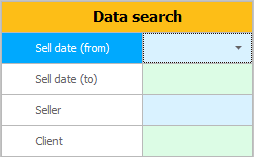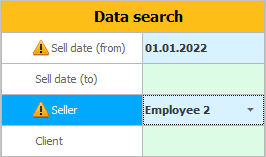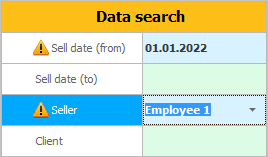Let's look at this topic using the example of the largest module - "Sales" . It should hold the most records as you will accumulate more and more sales every year. Therefore, unlike all other tables, when you enter this module, the ' data search ' form first appears.

The heading of this form is specially made in bright orange color so that any user can immediately understand that he is not in the mode of adding or editing a record, but in the search mode, after which the data itself will appear.
It is the search that helps us display only the necessary sales, and not flip through thousands and tens of thousands of records. And what kind of records we need, we can show using search criteria. Now we see that the search can be carried out in three fields.
Sell date . This pair option. That is, you can easily set any period by two dates in order, for example, to display sales only for the current month.
Seller is the name of the employee who made the sale. It can be either your retail salesperson or a sales manager specializing in wholesale supplies.
And the client who bought the item. If you set a search condition for this field, then you can display the entire sales history for a specific client . View his preferences, find out about the existing debt, and so on.
You can set a condition on several fields at the same time, for example, when you want to see the list of sales of a particular employee, starting from the beginning of a certain year.

The fields to be searched are marked with an exclamation point.
![]() The selection of a value in the search field is carried out using the same input field that is used when adding a new record to this table. Look at the types of input fields .
The selection of a value in the search field is carried out using the same input field that is used when adding a new record to this table. Look at the types of input fields .
![]() When purchasing the maximum configuration of the program, it is possible to independently
When purchasing the maximum configuration of the program, it is possible to independently ![]()
![]() configure access rights , marking the fields by which you can search.
configure access rights , marking the fields by which you can search.
Buttons are located below the fields for entering search criteria.
Button "Search" displays data that matches the specified search criteria. If the search criteria is all left empty, then absolutely all records of the table will appear.
Button "Clear" will remove all search criteria.
A button "empty" will show an empty table. This is required when you enter a module to add a new entry. In this case, you do not need any of the previously added entries.
Now let's press the button "Search" and then notice that in "window center" our search terms will be listed.

Each search term is marked with a large red arrow to draw attention to itself. Any user will understand that not all of the data in the current module is displayed, so you should not worry that they have disappeared somewhere. They will be displayed only if they meet the specified condition.
If you click on any search term, the data search window will reappear. The field of the selected criterion will be highlighted. This way you can quickly change the value. For example, click on the criteria ' Sold '. Then, in the search window that appears, select another employee.

Now the search terms look like this.

You can not aim at a specific parameter to change the search condition, but click anywhere "areas" , which is highlighted for displaying search criteria.
If we no longer need some criterion, you can easily remove it by clicking on the 'cross' next to the unnecessary search criterion.

Now we have one condition for data search.

It is also possible to remove all search criteria by clicking on the 'cross' next to the initial caption.

When there are no search terms, the criteria area looks like this.
But displaying all posts where a search form is specifically displayed is dangerous! Below you can find out what exactly it will affect.
![]() Read how your use of the search form affects program performance .
Read how your use of the search form affects program performance .
See below for other helpful topics:
![]()
Universal Accounting System
2010 - 2024